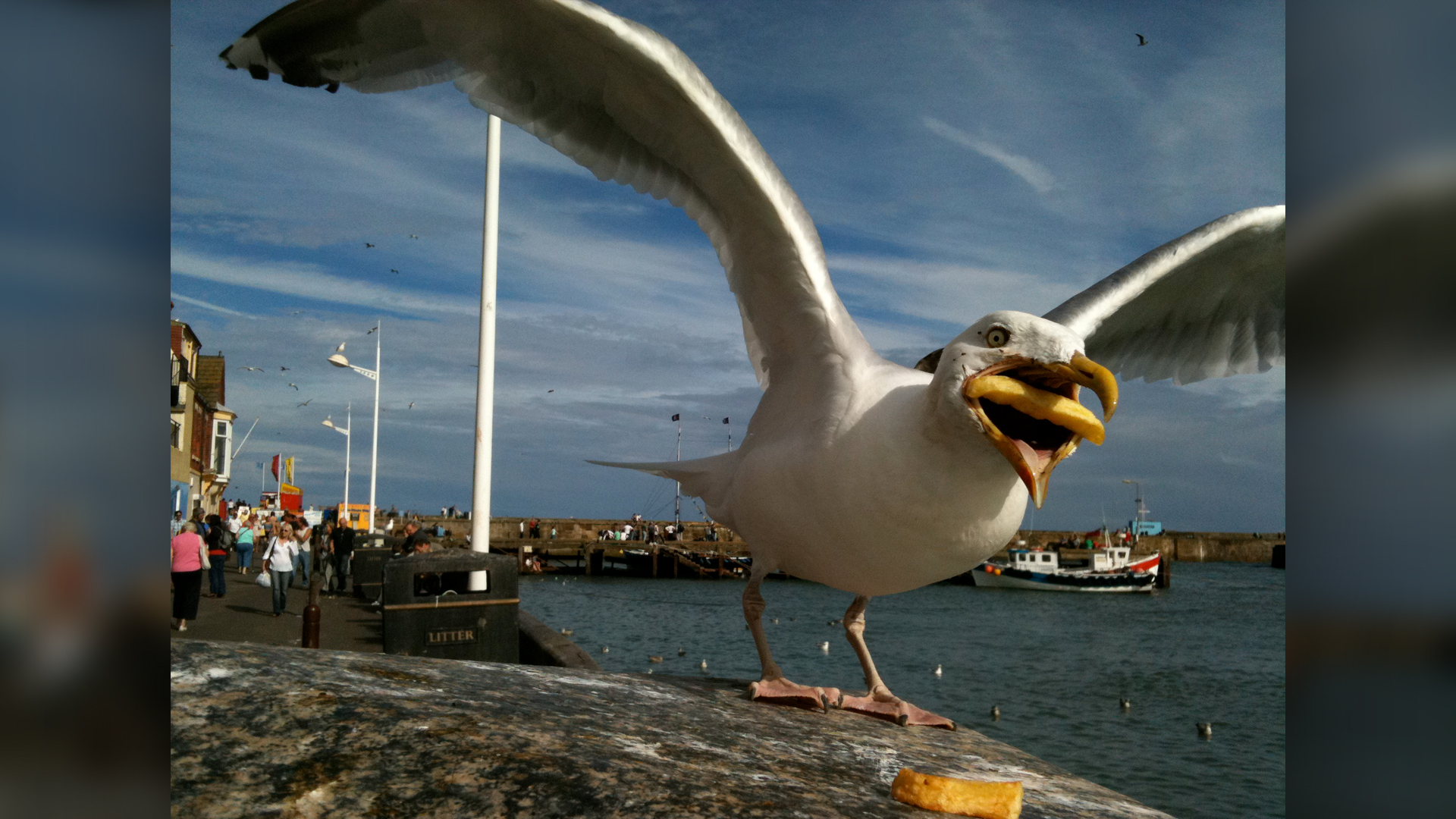This french-fry-stealing seagull is the star of a new Google ad
Herring gulls at the seashore are notorious for their food-snatching behavior.

An astonishing photograph captures the instant a seagull in the United Kingdom gaped its beak to snap up a french fry. The sight of a gull trying to nab human food is all too familiar to beachgoers, but hungry gulls usually move too quickly for people to catch them in the act. One moment, your french fries were right beside you. A second later, they're gone.
In this particular case, photographer Hannah Huxford encountered the fry-nabbing gull in Bridlington, a coastal town on the Yorkshire coast. Huxford snapped the well-timed photo on her iPhone in 2011; it went viral soon after. A decade later, the fry-stealing gull is appearing on billboards across the U.K. and Ireland, as part of an advertising campaign for Google, My Modern Met recently reported.
Related: Beastly feasts: Amazing photos of animals and their prey
The "cheeky" herring gull (Larus argentatus) was bold and fearless as it approached Huxford in Bridlington, while her husband tossed fries ("chips," in the U.K.) for the gull to catch, she wrote in a blog post in 2012.
"He was fascinating to watch and just wasn't scared of anyone, all he wanted was chips!" Huxford wrote. "I took many snaps of him on my iPhone 3G, it was only when I got back home to download the photographs that I found this amazing picture of him in mid gulp."
Local and national media outlets, including the BBC, snapped up the story as quickly as the gull snatched the french fry. Eventually, the media frenzy died down, but the gull's brush with fame wasn't over just yet. On March 22, Huxford posted on Instagram to commemorate the 10-year anniversary of the image, and a design firm promptly contacted her about licensing the photo, Huxford told My Modern Met. Her picture of the gull — captioned "What are you searching for this summer?" — is now appearing on Google billboards for 30 days and in online advertising for the company for the next 12 months, the BBC reported.
Exciting news my photograph of the #seagull eating a chip I took a decade ago on an iPhone 3 in Bridlington is now on a national @GoogleUK billboard campaign if you see it let me know #myphoto #myphotography #Bridlington #google pic.twitter.com/AL0dT9J2MQJune 6, 2021
Why are seagulls so interested in human treats like french fries? It's not just because they're plentiful and easy to steal. Researchers recently discovered that food may actually become more attractive to gulls when the birds observe humans handling it first, according to a 2020 study published in the journal Royal Society Open Science.
Get the world’s most fascinating discoveries delivered straight to your inbox.
Gulls that live in urban environments associate humans with food — from the trash that people leave behind, and from food they consume outdoors. Observing humans as they eat signals to a gull that there's food available for the taking, and the food may be safer or more desirable than food that humans haven't touched, the study authors reported.
"Our findings suggest that gulls are more likely to approach food that they have seen people drop or put down, so they may associate areas where people are eating with an easy meal," study co-author Laura Kelley, a biosciences research fellow at the University of Exeter in Cornwall, England, said in a statement.
"This highlights the importance of disposing of food waste properly, as inadvertently feeding gulls reinforces these associations," Kelley added.
If you'd prefer that seagulls leave you and your food alone, scientists suggest a simple solution: stare at them. Herring gulls are quick to approach and snatch treats that appear to be unattended, researchers reported in 2019 in the journal Biology Letters. But if you stare directly at the birds, they'll be more likely to slink away and look elsewhere for an ill-gotten dinner, Live Science previously reported.
Originally published on Live Science.

Mindy Weisberger is a science journalist and author of "Rise of the Zombie Bugs: The Surprising Science of Parasitic Mind-Control" (Hopkins Press). She formerly edited for Scholastic and was a channel editor and senior writer for Live Science. She has reported on general science, covering climate change, paleontology, biology and space. Mindy studied film at Columbia University; prior to LS, she produced, wrote and directed media for the American Museum of Natural History in NYC. Her videos about dinosaurs, astrophysics, biodiversity and evolution appear in museums and science centers worldwide, earning awards such as the CINE Golden Eagle and the Communicator Award of Excellence. Her writing has also appeared in Scientific American, The Washington Post, How It Works Magazine and CNN.


